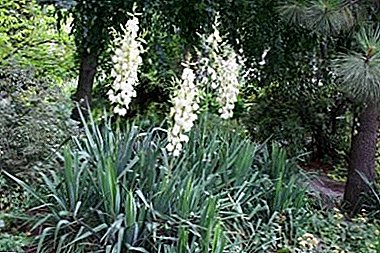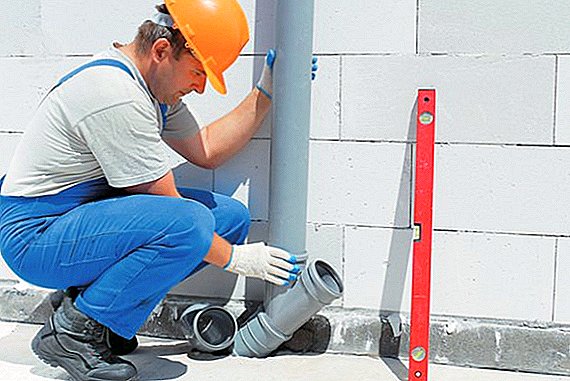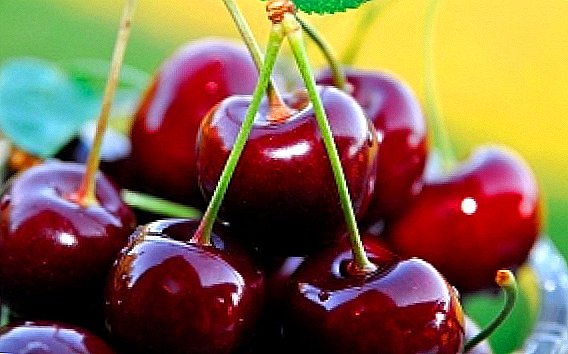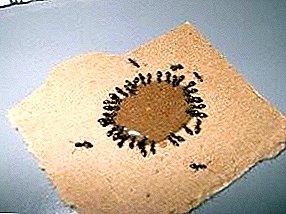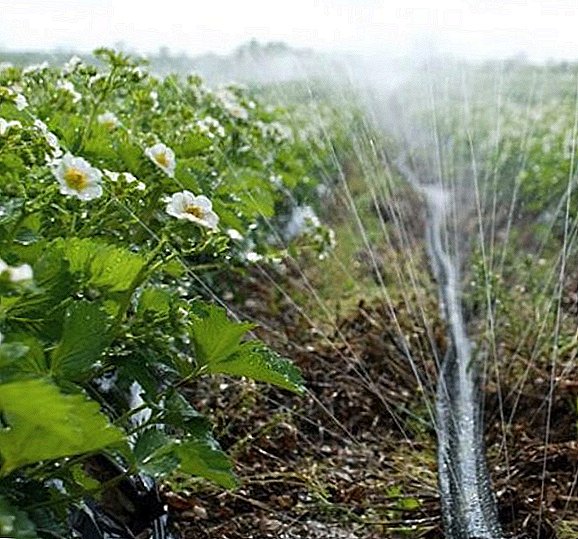 If you want to collect juicy and large strawberries, and even in large quantities, the bed should be moistened periodically. Superficial roots of the plant are not able to absorb moisture from the depths, therefore, when the topsoil dries out, they suffer from dehydration. But you can not pour over the bushes. Let's take a closer look at how often to water strawberries during the flowering and ripening of berries and whether it is possible to combine these procedures with dressings.
If you want to collect juicy and large strawberries, and even in large quantities, the bed should be moistened periodically. Superficial roots of the plant are not able to absorb moisture from the depths, therefore, when the topsoil dries out, they suffer from dehydration. But you can not pour over the bushes. Let's take a closer look at how often to water strawberries during the flowering and ripening of berries and whether it is possible to combine these procedures with dressings.
When to water
Strawberries are moisture-loving plants, therefore, in the period from early May to September there is an urgent need for regular and abundant watering. Their frequency depends on weather conditions and climate.
Did you know? In fact, strawberry fruits are small grains, which botanists call "nuts", and the berry pulp, which is usual for us, is just an overgrown receptacle.
At the beginning of the growing season, when it is still not so hot outside, it is recommended to water strawberry plants at least once a week. And on hot days, moisturizing procedures should be strengthened up to 2-3 times. If on your site sandy soils that quickly pass water, in the summer watering will have to be repeated every other day.  With this care, for the first three years, strawberry sockets will grow quickly and will develop properly. They will form the correct metabolic processes, and after harvesting there will be a lot of the beginnings of future fruits.
With this care, for the first three years, strawberry sockets will grow quickly and will develop properly. They will form the correct metabolic processes, and after harvesting there will be a lot of the beginnings of future fruits.
In the fall, excess moisture can lead to root decay and the development of pathogens. Therefore, in order not to expose the culture to risks, watering should be reduced to a minimum. On dry September days, the bed can be moistened every seven days, and in rainy weather this is not necessary.
Strawberry planting, located in sunny areas, is watered much more often than those in the shade. As a result, chains of complex physicochemical reactions to them ripen berries, enriched with sugars, glucose and fructose, which gives them sweetness and enhances the flavor.
Important! At one place strawberries can grow for about four years. Then it needs to be transplanted to new developed areas.
If the spring was successful dry, it is necessary to water the bushes from the second half of April. In cool seasons until mid-summer, the plant can be moistened three times a month. The main thing is to focus on the state of the soil and, of course, strawberries.
Find out about such strawberry varieties as: "Asia", "Albion", "Malvina", "Lord", "Marshal", Eliana, "Russian Size", "Elizabeth 2", "Gigantella", "Kimberly" and "Queen" .
All water procedures on a strawberry bed is desirable to carry out in the morning or evening. But try to keep the water drops out of the crop. 
What should be the water
Many owners, in order to facilitate the process of moistening strawberries, throw a hose with tap water over the garden bed. Of course, the berries on such a plantation will be, but watering with cold water is highly discouraged by experts. In their opinion, the risks of developing putrefactive infections increase, and the root system of the plant weakens, which, in turn, affects the quantity and quality of its crop.
It is best to collect water in large tanks for settling and heating. By the way, if you do not want to bother yourself with full buckets, a tap with a hose can also be adapted to the barrel or tub. Warm fluid affects growth hormones, stimulating their activation. As a result, the bushes grow well and are distinguished by early ripening of berries.
Did you know? Few ladies know that strawberries can replace the most expensive face cream. The fact is that berries in large quantities contain copper, which is responsible for the production of collagen. That is why it is very useful to prepare masks from it. The effect will be the same as from the brand and almost not affordable cosmetics.

Watering rules
To figure out how to water the strawberries, it is important to understand the basic requirements of the plant for a certain period of development. After all, someone who loves to feast on these berries, probably already guessed that the lack of moisture, like its excess, affects the taste characteristics. Consider in stages all the subtleties of moistening the culture.
After landing
In order for the young processes with tendrils to form flower stalks, it is important for them to ensure an adequate level of moisture in the ground. Experienced gardeners are advised not to overdo the amount of water poured under the roots, because the transplant process usually occurs in spring or autumn, when it is not hot outside.  In the first two weeks after planting, it is recommended to pour half a liter of warm water under each bush. Moreover, it is desirable to do this procedure up to three times a day. In the future, the grown-up layers should be distributed weekly from 10 to 12 liters of fluid per square meter.
In the first two weeks after planting, it is recommended to pour half a liter of warm water under each bush. Moreover, it is desirable to do this procedure up to three times a day. In the future, the grown-up layers should be distributed weekly from 10 to 12 liters of fluid per square meter.
Important! In the long rains and cold wet weather, be sure to cover the strawberries with a wrap. It will contribute to the formation of the microclimate necessary for increasing biomass and strengthening the roots, as well as prevent the development of fungal diseases and putrefactive infections.
Many owners of strawberry plantations in the early stages of the development of young plants use purchased sprinklers. But their use is allowed only before budding, since the risks of pollen off the stamens are very high.
How to water strawberries after planting depends largely on the characteristics of the soil. For example, sandstones require from 50% moisture, and loams - from 60%. Experts advise to moisturize the plant rarely, but abundantly, because frequent and minor irrigations do not give the desired effect.
At the beginning of the growing season of strawberries, special attention should be paid to the soil. After each watering it is desirable to loosen and moderately necessary to clear weeds. These manipulations will improve the aeration of the roots and allow them to feed more intensively. Remember that light substrates require less water than heavy ones. 
During flowering
If in this phase of development of the bushes they do not provide them with the necessary water regime, large losses in yield and a strong depletion of the culture are possible. To avoid this, for every square meter of beds you need to pour 20-25 liters of water.
Did you know? Lemon contains much more sugars than strawberries.
Some adjustments regarding the amount of liquid poured may make the physico-chemical characteristics of the substrate. But in all cases, make sure that the soil was soaked to a depth of 25 cm.  For moisture retention, it is recommended to cover the aisles with coniferous mulch, straw or black film. These materials will not allow the development of weeds, in addition, protect the flowers and berries of the plant from contact with a wet substrate. As a result, they will not be affected by rot.
For moisture retention, it is recommended to cover the aisles with coniferous mulch, straw or black film. These materials will not allow the development of weeds, in addition, protect the flowers and berries of the plant from contact with a wet substrate. As a result, they will not be affected by rot.
During the fruiting period
The first ripe strawberry fruit can be found on June. But some owners, thanks to competent irrigation and fertilizers, for the season can collect several harvests. We asked them how often to water strawberries during fruit bearing and ripening berries.
It turns out that for such a success, a square meter of planting in hot weather will take about 25 liters of water. On sandy substrates during this period, it is important to maintain humidity at 70%, and on loams - about 80%.
Did you know? The size and color of strawberries affect the contents of the berries. Scientists believe that bright saturated color is a clear indicator of a large amount of vitamins.
Remember that sockets are especially in need of moisture when they are formed Zelentsy. Therefore, monitor the condition of the mulch and do not allow a dry crust to form on the ground. Many gardeners make special grooves between rows, where water is directed. This technology does not endanger pollen and protects berries from rot. 
Watering and feeding
The combination of these two vital procedures for strawberry can work wonders. The culture is very dependent on the mineral components of the substrate. They are better absorbed by the roots in a humid environment.
Before planting outlets, experts advise that the bed be fertilized with a mixture of humus, superphosphate and wood ash. Per square meter of the plot, the ratio of components is calculated by the proportion of 3 kg: 35 g: 500 g. Then it is important to put a little humus or rotted (but not fresh) manure into the well under each bush.
Learn more about strawberry feeding in spring and autumn.

Important! When planting strawberries in the spring in the spring, it is imperative to remove dry foliage and regrown mustache from the row spacing from the sockets.
On old berry plantations, the first dressing is planned during the period when the bushes start to throw out young leaves, the length of which does not exceed 10 cm. Then a solution of 3 kg of dry mullein, which must be diluted with water and infused for about three days, and a bucket of water will be very appropriate. Alternatively, you can use the infusion of chicken manure.  Repeated fertilizer is carried out when flower stalks appear from the outlets. During this period, about 20 g of ammonium nitrate dissolved in a bucket of water should be added to the root. This fluid should be enough for 20-25 bushes. If desired, you can adjust the taste and commodity qualities of the berries by adding organic matter at the beginning of fruiting.
Repeated fertilizer is carried out when flower stalks appear from the outlets. During this period, about 20 g of ammonium nitrate dissolved in a bucket of water should be added to the root. This fluid should be enough for 20-25 bushes. If desired, you can adjust the taste and commodity qualities of the berries by adding organic matter at the beginning of fruiting.
We advise you to learn about how to grow such berry crops as: blueberries, blueberries, sunberry, cranberry, cloudberry, raspberry and lingonberry.
The time of the next feeding will come only after all the berries have been gathered. At this stage of strawberry development, it is recommended to remove old foliage from the sockets and to add toxic chemicals from fungal and bacterial diseases during irrigation. The best tool in this period, many gardeners consider a three percent solution of potassium permanganate. It is an effective antiseptic and fertilizer.
Important! Remontnye varieties of strawberries recommended fertilize during each wave of formation of ovaries.
On strawberry beds, whey has proven itself well. In rural areas, it is often used as a fungicide, insecticide, and fertilizer. The liquid contains nitrogen, phosphorus and potassium, without which the plant cannot fully grow.
Features of drip irrigation
Given the fact that strawberries prefer abundant soil moisture, many owners, in order not to carry water-filled buckets, install drip irrigation on their land. In addition, it is welcomed by experts. In their opinion, with this method of watering the plant for a long period is provided with moisture and protected from its excess. The liquid comes under the roots, it does not splash on the foliage and flowers, thereby reducing the risk of sunburn and pollen flushing. A solidified crust never forms on the soil.  You can build a drip system yourself. For this you need pipes, droppers, drip tapes, pressure regulators and a water pump. It is important that the improvised installation could regulate the intensity of moisture during budding and the formation of berries. Competent organization of irrigation and fertilizing is the key to successful cultivation of strawberries. We hope our recommendations will help you to achieve abundant and high-quality fruiting.
You can build a drip system yourself. For this you need pipes, droppers, drip tapes, pressure regulators and a water pump. It is important that the improvised installation could regulate the intensity of moisture during budding and the formation of berries. Competent organization of irrigation and fertilizing is the key to successful cultivation of strawberries. We hope our recommendations will help you to achieve abundant and high-quality fruiting.





